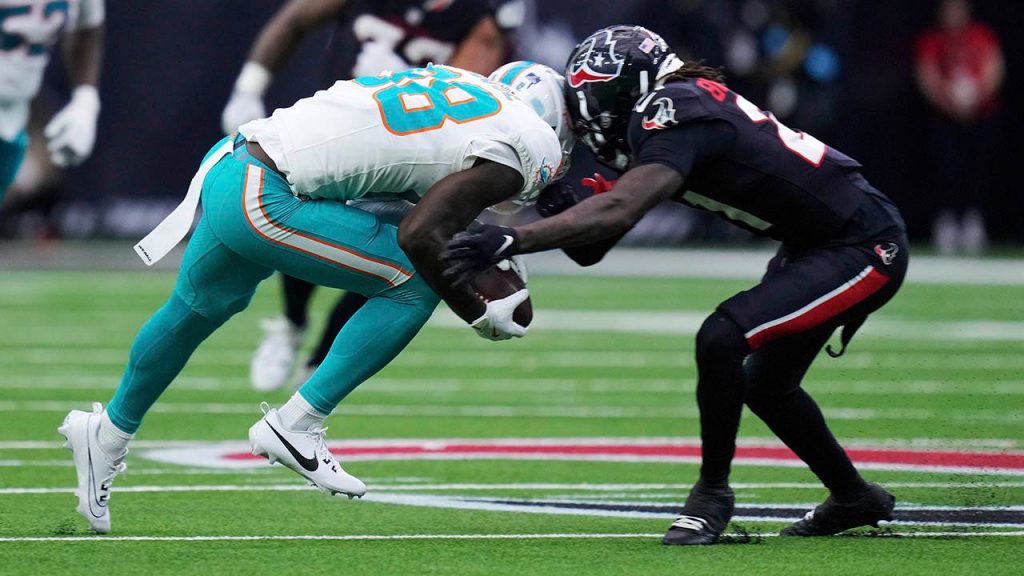The Miami Dolphins preseason game against the Houston Texans on Sunday was marred by a frightening injury to wide receiver Grant DuBose, raising concerns about player safety and the potential for disciplinary action. The incident unfolded when Texans defensive back Calen Bullock delivered a jarring hit on DuBose, leaving him motionless on the field. Medical personnel rushed to his aid, cutting away his jersey and shoulder pads before carefully placing him on a stretcher and transporting him off the field. DuBose was subsequently taken to the hospital, where he remained overnight for observation and further evaluation.
Bullock, while expressing remorse and concern for DuBose’s well-being, maintained that he had no intention of inflicting harm. He described the play as a forceful but unintentional collision, emphasizing his focus on the ball and his instinctive reaction to the developing play. He stated, “My intention was never to go out there and just try to completely take someone out of the game and hurt somebody…My intentions were never to go out and hurt nobody, that’s never any of our intentions.” Despite his claims of unintentional contact, Bullock was penalized with a flag on the play. The incident immediately sparked debate about the legality and ethical implications of the hit, with some observers questioning whether it warranted further disciplinary action.
DuBose’s reaction following the hit added to the concern. He exhibited clenched fists, a movement consistent with the “fencing response,” a neurological posture often associated with concussions or other head injuries. The presence of this involuntary reaction heightened anxieties about the severity of DuBose’s injury and underscored the potential dangers inherent in high-impact collisions in football. The incident resonated particularly strongly with Dolphins quarterback Tua Tagovailoa, who has personally experienced the debilitating effects of multiple concussions during his NFL career.
Tagovailoa expressed empathy for DuBose and lamented his own role in the play, questioning his ball placement and decision-making that led to the receiver being vulnerable to such a forceful hit. He reflected on his own concussion experiences, stating, “We all know that I’ve gone through something similar, and that’s no fun…You never want to be put in any of those situations, but you also understand that this is a physical sport. It’s a contact sport.” Tagovailoa’s comments highlighted the complex interplay between the inherent physicality of football and the responsibility of players and coaches to minimize the risk of serious injury. His words also underscored the emotional toll that such incidents can take on players, particularly those who have experienced similar trauma.
This incident is the second in consecutive weeks involving a controversial hit by a Houston Texans player. In their previous game against the Jacksonville Jaguars, Texans linebacker Azeez Al-Shaair delivered a hit on quarterback Trevor Lawrence that resulted in a three-game suspension. The proximity of these two incidents has drawn attention to the Texans’ tackling techniques and raised questions about the team’s coaching and player discipline. The NFL’s response to Bullock’s hit on DuBose will be closely scrutinized, as it will signal the league’s stance on player safety and its commitment to enforcing rules designed to protect players from potentially career-ending injuries.
The DuBose injury fuels the ongoing discussion about the balance between the inherent violence of football and the need to protect players. The incident raises several key questions. Should the league implement stricter penalties for hits that result in serious injury, even if unintentional? How can coaching staffs better train players to tackle safely and effectively while minimizing the risk of head and neck injuries? And how can the league improve its protocols for evaluating and managing concussions and other head trauma to ensure the long-term health and safety of its players? These are complex issues with no easy answers, and the DuBose incident serves as a stark reminder of the ongoing challenges facing the NFL as it strives to make the game safer for all participants.

